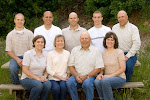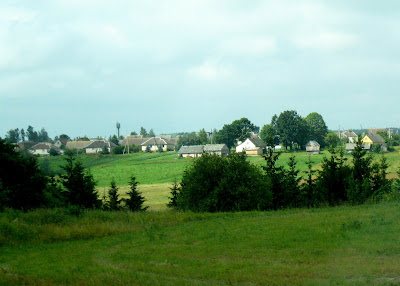We enjoyed the scenery as we traveled by car with Elder & Sister Boehm from Riga, Latvia to Kaunas, Lithuania, where Sam had another welfare training meeting with the district presidency.
Traveling between Latvia & Lithuania
 Border between Latvia and Lithuania
Border between Latvia and Lithuania Sam especially enjoyed seeing the farm land.
Sam especially enjoyed seeing the farm land.Blue sky, lots of trees, green grass, and
horse & wagon -
make a perfect pastoral setting.
 Of course, a cow grazing completes the scene.
Of course, a cow grazing completes the scene. Out in the country by a motel and cafe
Out in the country by a motel and cafewas a display of about six vintage airplanes,
includng this MiG-21.
We saw quite a few stork nests built high above the ground. We were told the farmers like to have a nest with storks on their land, as storks are supposed to bring good luck.
St. Michael Archangel Church
in Kaunas, Lithuania
in Kaunas, Lithuania
Upon arriving in Kaunas, we strolled down the main pedestrian street, which is one of the longest pedestrian streets in Europe. At the end of the street was the St. Michael Archangel Church (pictured above). We ate at a restaurant where the Boehms had eaten and recommended the ethnic food.
Sister Boehm and I waited at the church while Sam and Elder Boehm met with the district presidency. President Dance was at the meeting, too. The purpose for Sam to be there was to discuss welfare principles and provide training. After the meeting, we went to the hotel and visited while we had a nice dessert.
The next morning, we left for Liepaja where the Boehms are serving their mission. On the way, we saw more country scenery and the Hill of Crosses.
The next morning, we left for Liepaja where the Boehms are serving their mission. On the way, we saw more country scenery and the Hill of Crosses.
The Hill of Crosses is a pilgrimage center in Lithuania where the tradition of leaving crosses goes back to the 1200's when it represented peaceful Catholic resistance to oppression. During the Soviet era, Lithuanians went to the Hill of Crosses as an expression of their nationalism. The Soviets repeatedly removed the crosses and leveled the hill three times, and the crosses were burned or turned into scrap metal. Each time the crosses were removed, the people would come in the middle of the night and put them back. Today people come from all over the world to put up a cross.
 Close-up of the Hill of Crosses
Close-up of the Hill of Crosses Sam & Narene on a path at the Hill of Crosses.
Sam & Narene on a path at the Hill of Crosses. The Boehms (serving in Liepaja)
The Boehms (serving in Liepaja) There are crosses hanging on crosses.
There are crosses hanging on crosses. Pope John Paul II visited here in 1993.
Pope John Paul II visited here in 1993. As we traveled, we saw quite a few yellow fields.
As we traveled, we saw quite a few yellow fields.They might be canola, but we don't know.
 These fields were "pretty as a picture."
These fields were "pretty as a picture." Another yellow field.
Another yellow field. A small village.
A small village. A country home.
A country home.




















































